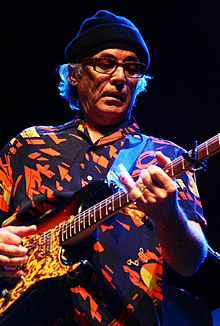
In music, a guitar chord is a set of notes played on a guitar. A chord's notes are often played simultaneously, but they can be played sequentially in an arpeggio. The implementation of guitar chords depends on the guitar tuning. Most guitars used in popular music have six strings with the "standard" tuning of the Spanish classical guitar, namely E–A–D–G–B–E' (from the lowest pitched string to the highest); in standard tuning, the intervals present among adjacent strings are perfect fourths except for the major third (G,B). Standard tuning requires four chord-shapes for the major triads.
There are separate chord-forms for chords having their root note on the third, fourth, fifth, and sixth strings. For a six-string guitar in standard tuning, it may be necessary to drop or omit one or more tones from the chord; this is typically the root or fifth. The layout of notes on the fretboard in standard tuning often forces guitarists to permute the tonal order of notes in a chord.
The playing of conventional chords is simplified by open tunings, which are especially popular in folk, blues guitar and non-Spanish classical guitar (such as English and Russian guitar). For example, the typical twelve-bar blues uses only three chords, each of which can be played (in every open tuning) by fretting six strings with one finger. Open tunings are used especially for steel guitar and slide guitar. Open tunings allow one-finger chords to be played with greater consonance than do other tunings, which use equal temperament, at the cost of increasing the dissonance in other chords.
The playing of (3 to 5 string) guitar chords is simplified by the class of alternative tunings called regular tunings, in which the musical intervals are the same for each pair of consecutive strings. Regular tunings include major-thirds tuning, all-fourths, and all-fifths tunings. For each regular tuning, chord patterns may be diagonally shifted down the fretboard, a property that simplifies beginners' learning of chords and that simplifies advanced players' improvisation. On the other hand, in regular tunings 6-string chords (in the keys of C, G, and D) are more difficult to play.
Conventionally, guitarists double notes in a chord to increase its volume, an important technique for players without amplification; doubling notes and changing the order of notes also changes the timbre of chords. It can make possible a "chord" which is composed of the all same note on different strings. Many chords can be played with the same notes in more than one place on the fretboard.
